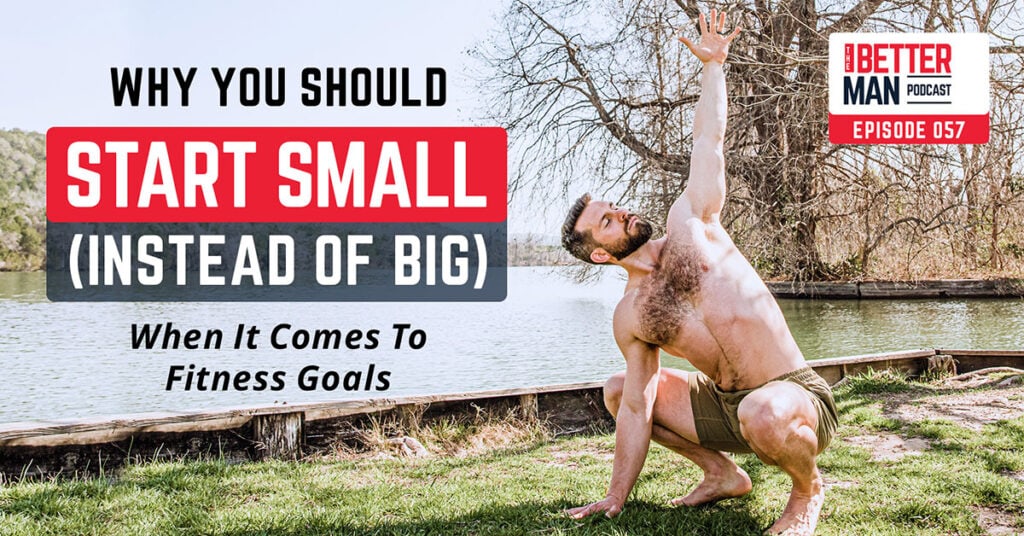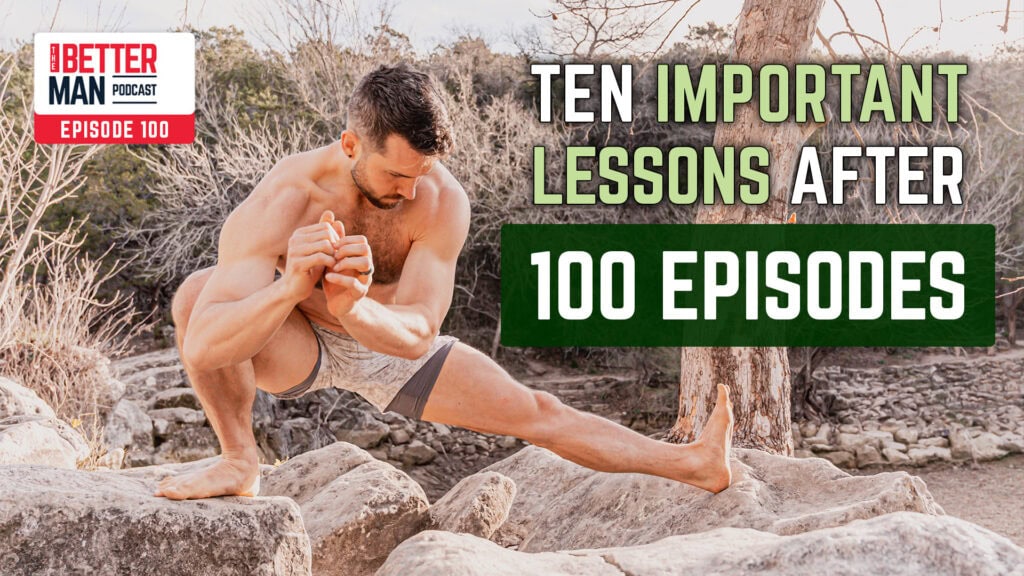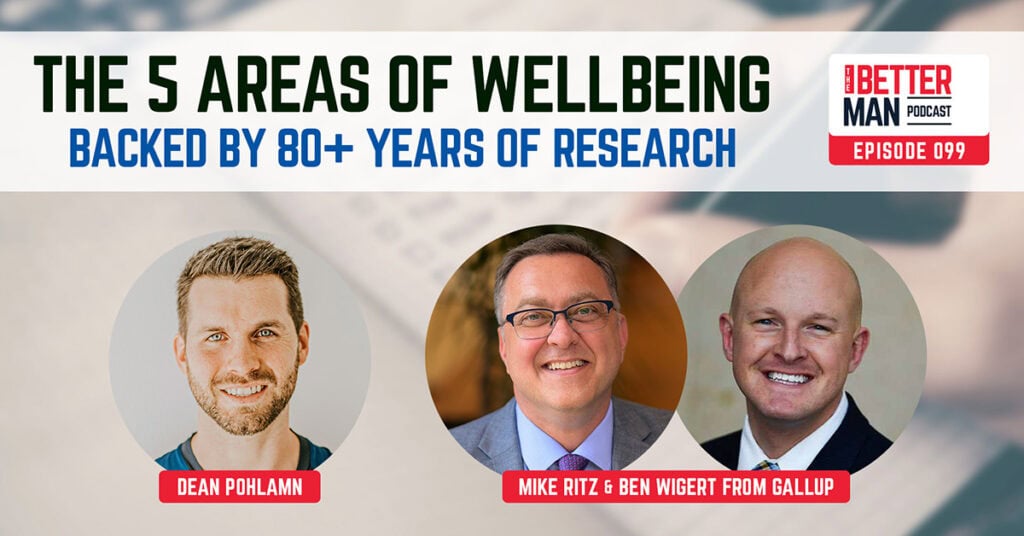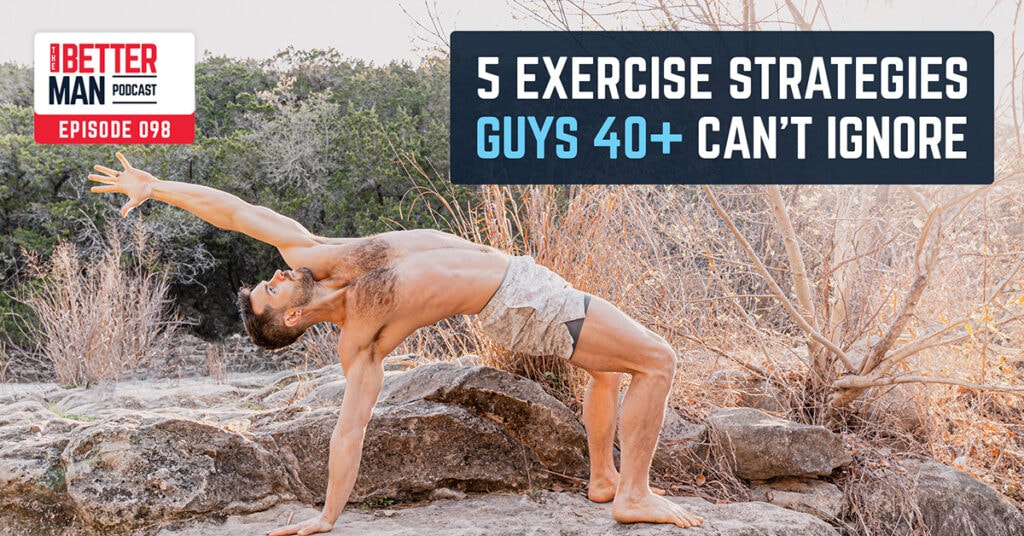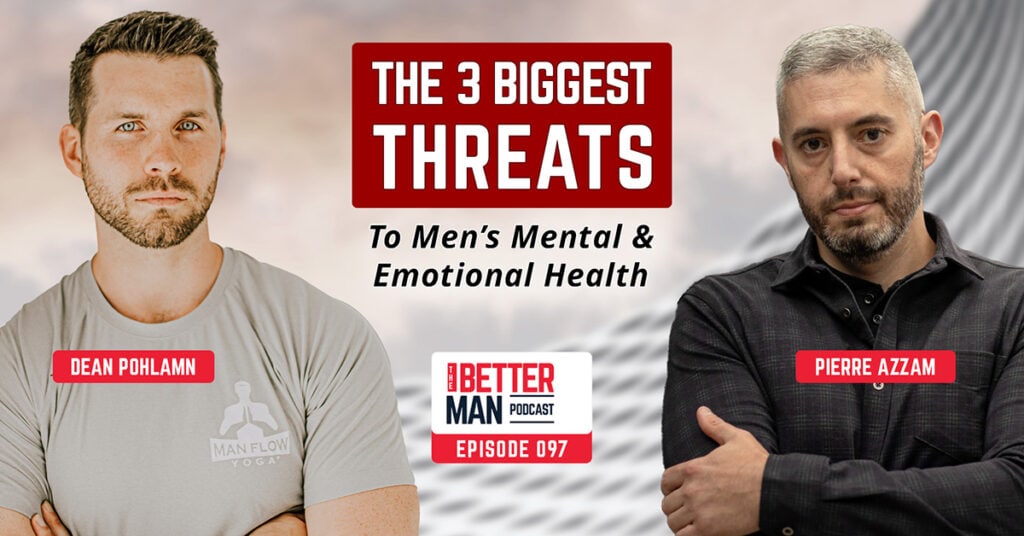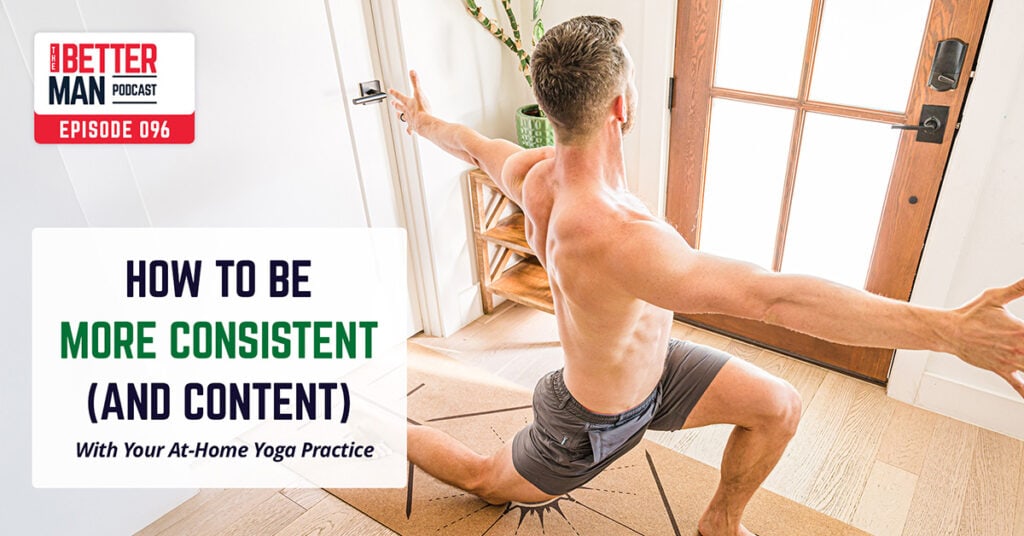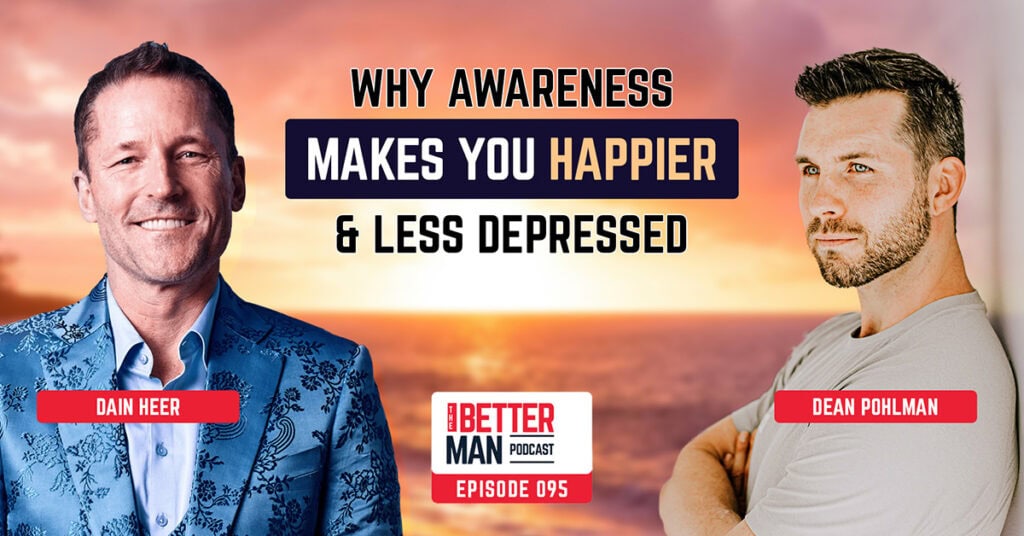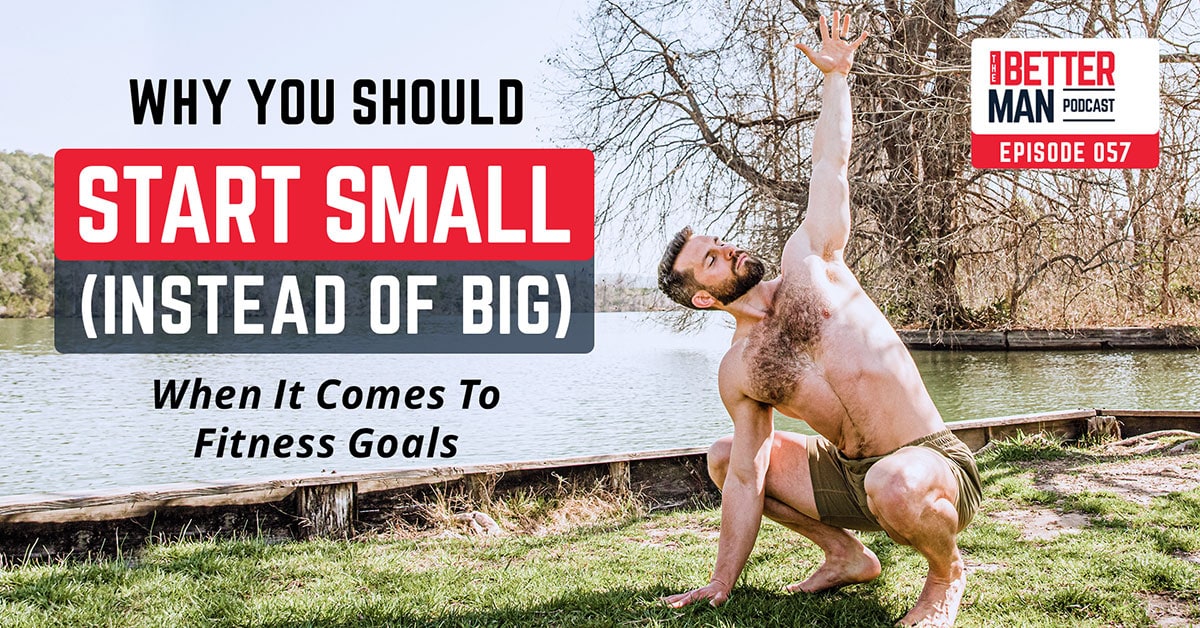What’s up, guys? It’s Dean. Welcome to the A Better Man podcast. Today’s episode is a solo episode, and I’m going to be talking about the importance of starting small. So whether you are starting a new workout program, if you are trying out new nutrition guidelines, if you’re implementing an evening routine, whatever this is, you want to start small.
The temptation is to make this big elaborate plan, but you’re going to be more successful. Your habit is going to last. The longer it will be easier and more joint enjoyable, and you’re also less likely to get hurt when you are starting small instead of making a big dramatic plan. I’ll give you an example from my own life.
So this year I started doing a cold plunge. So cold plunge cold water therapy. Basically I have this tub in my backyard that is kept at a cold temperature. I started at 53 degrees and then I go in there for a certain amount of time and then I come out. Now, when I first started this, the goal was is eventually to get to the coldest temperature.
Eventually I want to get this cold pulled down to 37 degrees and do it for 3 to 5 minutes every day. Now, I knew that if I did that right away, it would be really hard. It might be it might be not very enjoyable to do. And I also might end up getting sick from getting in the water, getting in that cold water that I was that that cold of the temperature and staying there for that long.
So instead what I did is I applied these principles of starting small. I made it easier by lowering the amount of time required in it. So I only did ten breaths to start. I also did a higher temperature. So instead of doing a super low temperature in the 30 in the thirties and this is Fahrenheit we’re talking about, I set the temperature to 53 or 55 degrees, which is still pretty cold.
If you get in cold water, it’s still cold, but it’s not nearly as cold as 37 degrees. And I also didn’t force myself to do it every day. I said, okay, I’ll I’ll do it every three days. The first month. I actually did do it every day because I wanted to stick with it. But after that, I didn’t require myself to do it every day because I didn’t want to do it more than I wanted to.
I didn’t want to have to force myself to do it. Because if you’re forcing yourself to do something, then it’s not likely to last. So look, let’s fast forward to June now. I just got out of my cold plunge this morning. I do it 4 to 5 times a week. The temperature that I use is currently 46 degrees.
I stay in it for ten breaths. I hold my breath underwater for as long as I can, and then I do five more breaths after that and it ends up coming out to about three, four or five, sometimes even 6 minutes, depending on how slow I’m breathing. So I started small. I made it easy. I made it so that my motivation by my level of motivation was relatively low.
In order to do it, I built up my ability to withstand the cold water so it’s easier. And now I’m closer to where I want to be, but only because I started small. So I give you this perfect personal example from my own life, because there is this tendency, even for me to look at new habits, to look at things that I want to start doing, and to just think, oh, I’m, you know, I’m really disciplined.
I’m really good with fitness, so I’ll be fine if I start off doing 60 minutes a day or I’ll start doing like 30 minutes a day, or I’ll do it every day and I’ll just be able to do it no matter what, because I’m really disciplined. And the reality is that I am a human being like everybody else.
And I know that if I want to be successful or something, I should start small. I should make it so that my my required motivation to do this is low. I should make it so that it’s relatively easy relative to my skills and my abilities, and I should attach some sort of time frame to it. This is important as humans, it’s really hard for us to conceptualize anything beyond 28 days or about one month.
So if we say I’m going to cold plunge every day, just and that’s the goal, that is a daunting task that is way too much to commit to and there’s no sort of time frame attached to it. There’s no sort of clarity because you either be successful when you do it every day for the rest of your life, or you fail.
If you don’t do it every day and then you get discouraged and you don’t do it anymore. So the one other thing that I did when I started was I attached a time frame to it. So I said for the first month, I’m going to do it every day for the first month. And I did it every day for the first month.
But I was only able to do that because I put that time frame on it. I didn’t say, I’m going to do this every day for ever for one year. I said, I’m going to do this every day for one month. So I was very clear on that timeline. And there’s a few reasons why. There’s a few other reasons why it’s important to to use a timeline and also to to use kind of a relatively lower timeline.
So, you know, if you want we mentioned 28 days, but it’s you can also plan this out and you can try it out for one week. You can try it out for two weeks when people are doing man flow yoga programs. I always say, look, let’s give this a shot for one week, two weeks. What’s come up with the plan?
Let’s test it out. Let’s see if that plan works for you and then let’s reassess, assess at the end of the week or at the end of two weeks, and we’ll figure out what’s working and what’s not working. And sometimes you just need to stick with it for a couple of days or a few days to realize that, oh, okay, this is possible.
This is something that I can do. And if you look at it for the first one day of the first two day, it might seem impossible. But then you actually do do it for a few days and you’re like, okay, this is possible. I just had to show myself that I could do it. It’s easier than I thought it was on the other hand, you could do something and realize that it is more difficult than you thought it would be, and it’s not sustainable.
And that’s when you want to go back at the end of that one or two week period and reassess and make a plan, figure out, you know, how am I going to make this more feasible, How am I going to make this so that it works? And again, it’s really important to mention this idea of making it easier and making it require less motivation.
There’s a big tendency for us to assume that we’re always going to be motivated to do something. Instead, what is a good idea to do is to plan for your least amount of motivation. So think of the day when you wake up, when you feel the least motivate it. And that’s what I want you to plan for. So you cannot assume that you’re going to have a high level of motivation.
And when we start small, you don’t need as much motivation. You know, if you if you only have you know, if you’re if you’re the the the relative motivation of whatever you’re trying to do is low, you don’t need that much of a push to be able to do it. You don’t need a psych yourself up to do it.
If you also choose to do something that has a lower level of required ability, meaning if it takes less effort, if it takes less money, if it takes less skill, there’s a lot of things that go into the ability of us of a habit or of behavior. And if you can choose behavior or scale it back in a way.
So that it doesn’t take as much skill, ability or time, then that’s also going to help. A really good example of this is our Strength Foundation’s challenge. So our Strength Foundation’s challenge is a really popular challenge. We have a a Facebook ad that we’ve been running for it for years now. It’s one of the main ways that people find out about Man Flow yoga.
And it’s a six week program. It’s a six week challenge. It’s five days per week. But the workouts are intense and they’re about 35 minutes long. So for a lot of people, this is too much. People get in and they try it and they get in about a week and they end up feeling really discouraged because the workouts are either outside of their skill level or their ability.
Maybe they don’t have as much time as they want. Maybe it’s just for whatever reason, it’s not working out for them and they come into the Facebook group and they post, Hey, this isn’t working out. You know, I feel really bad about myself. And, you know, there’s a few things that and I bring this up because it’s important to help you understand why this is totally normal for a lot of people.
We as humans want to do the least amount of work possible for the greatest reward. So when we are trying to do something new and it takes us 30 minutes a day and we are and we’re not able to do it continuous, we were not able to stick with the plan. Not only is that not only is that, you know, we’re not being successful at that.
We’re not seeing the results of those immediately. And that’s discouraging. But it’s also discouraging because it is kind of it’s kind of showing us that we it’s kind of it’s creating this mindset of failure. It’s it’s reinforcing this idea. And this is especially important if you have had difficulty with being consistent with workout programs in the past. But it’s reinforcing this idea that you are not successful with fitness programs.
So that’s a big reason why we would want to change the approach as well. If you’re doing something and you’re feeling and it’s creating this this idea of failure or you’re not measuring up to your standards, then that’s also a reason that we’d want to change. But for these people, what I actually recommend is we want to scale it back.
How do we make it easier? How do we make it take less motivation? So instead of having you do a workout program that’s five days per week and 30 to 35 minutes per day, maybe the first step would be scaling it back to three days per week. Maybe if we do these workouts three days per week instead of five days per week, that can seem much more manageable.
Now, that might be a good step that might work for you. However, if the workouts are still too difficult and you’re doing them and you’re feeling discouraged and that the amount of the amount of effort, the amount of motivation to do them is just too high, then we’d want to scale it back to an easier program, which is where I’d introduce something like, for example, I have a program called Absolute Beginners Program, and these workouts are 15 minutes and they’re actually made with the whole idea that kind of goes into this idea of starting small, which is doing workouts that are a lot easier, that allow you to build up, that don’t take as much
effort, that don’t take as much skill, that don’t take as much, you know, intensity. And so we make it easier and we also make it smaller, right? It’s only 15 minutes instead of 35 minutes. So that motivation level is is lower and you don’t have to exert as much effort. So that’s something that’s really important. That’s again, that’s just a good example of this idea of starting small.
And now a lot of people get, you know, they think that they need to do something dramatic in order to get results or they think that they need to do something big in order to get the results that they want. But the only way that you’re going to get those big results is by establishing consistency. And for most of us, the best way to establish consistency is to smart, to start small, to create consistency, to create the consistency of something that’s really relatively easy to do and then build on top of that.
So it’d be much better for you to start with a goal of, let’s say, doing one yoga pose or one minute of exercise every day for a week and then showing to yourself, I did this every day for a week. I can be consistent with that and then increasing the difficulty of that over time, but only scaling it in a way that is manageable.
So maybe you do. And this sounds ridiculous, like, well, what’s one minute of exercise going to do per day? Yes, one minute exercise per day is not going to do that much if that’s all you ever do. But if you do it with the intention of scaling it up, you’re creating consistency that you can build upon rather than starting off with something that is, you know, 30 minutes of exercise per day.
That’s great. Like what’s build up to being able to do that? But not all of us can start with that because it takes a high level of motivation, it takes a high level of effort to be able to do that. But if we can establish that consistency where we’re doing 1 minutes a day or 2 minutes per day, over time, we’re going to be able to build that up.
Right. And something that, you know, you might not be considering is that a lot of these endeavors that we’re talking about, a lot of these fitness endeavors, they’re meant to be long term, right? These aren’t things that you want to do for just one or two weeks and then end up quitting. This is something that ideally you’re creating a habit of that’s going to last for the rest of your life in the rest of your life.
That’s a really long time, right? So you don’t have to create your dream habit or you’re the highest standard of your dream habit. In the first month. You can start small and you can build from there because if you look at, you know, the results of one month of failure versus six months of really easy, low level, low ability things, and then you look at where you are 12 months later, the really small habit that you built and started with that will grow over time and it will seem relatively easy because you built the you built the the difficulty over time.
You started small, you made it easy, and then you made it just a little bit harder in a logical progression over time. Instead of starting hard and then failing and then getting back to where you were a month ago and then just setting yourself up with this this kind of this repeated mindset of I good at working out for like the first month, but then I give up.
So instead of doing that, the goal is again to shift to this mindset of consistency and long term, making it easy, making it enjoyable, right? God forbid that you enjoy your workout programs, by the way, and if you don’t enjoy you know, if you’re if you’re not enjoying what you’re doing with your fitness, then that’s a good idea.
That’s a good sign that you should change it. One reason why I say stick with something for at least a week or two week is because it might not seem enjoyable at first. There are some you know, there there is a learning curve to a lot of activities. So, you know, you might be frustrated when you don’t know the technique yet.
You might be frustrated when you’re just not familiar with it. And there’s a lot of confusion. But if you can stick with something for a decent amount of time and get over that learning curve and get to the point where you feel somewhat confident and you’re starting to enjoy the benefits of what you’re doing and you’re starting to enjoy some of the process itself.
Now you’ve you’ve gotten through that adjustment period and that that adjustment period is difficult with with with nutrition. It’s a it’s it can be a four week period where you’re shifting from eating unhealthy foods to eating healthier foods. It takes your body some time to adjust that just to that. It’s the same thing with working out. It might seem more difficult at first because in addition to starting this workout program, you’re also exerting energy on all the other things in your life and all the other responsibilities in your life, your family, your job, all of these other things that demand your time and energy and you’re starting a workout program on top of this.
And chances are, if you’re not working out consistently, you don’t have great energy levels to begin with. And now with these low energy levels, relatively low energy levels, we’re asking you to also work out with that. So there is this adjustment period where you’re going to have less energy, but over time, as you work out consistently, your body builds a higher baseline of energy.
And so it will get better after three or four weeks. But there is that initial adjustment period where it’s going to be difficult. And that’s why I like this idea of planning things out in 28 days, right? So using that, using using this framework of 28 days, trying something for one month and then also being able to reassess that at regular intervals as you’re going through it.
So if you want to adjust it at the end of the week, figure out, okay, what didn’t go well here? Did I choose a time of day where I didn’t have a high level of motivation, where I just didn’t feel good? Did did it take longer than I expected? Do I not have the necessary skills? Did I not know how to do it properly?
So there are it’s good to be able to reassess at regular intervals. But again, starting with that 28 day guideline or that that 28 day, you know, kind of timeline is a really good idea. Okay. I think I cut out, possibly cut out here. So again, starting with that 28 day guideline, it’s a really good idea because it does give you enough time to see the results, but it also gives you it also is soon enough in the future that it doesn’t seem like this long term, forever kind of task.
Now there’s also this a common myth that it takes 28 days to form a new habit. There’s actually no sort of basis for this statement in behavioral science. I read a lot of behavioral science books. A lot of my ideology from this start small comes directly from a book called Tiny Habits by b.J Fogg. I also I’m a big fan of Atomic Habits by James Clear, and there’s some other books out there that I haven’t read on Habit Formation that I want to get that I really want to get into.
But those are two really good ones, and the way that habits are formed depends on the effectiveness of the habit. So it could just be one habit could be formed in one day, it could just take one instant if what you did solved for the solution you were looking for. If if what you did solve the problem you were trying to address incredibly effectively and quickly and easily, that habit could be established immediately and doesn’t have to take 28 days.
On the other end, if you are forcing yourself to do something every day and you don’t enjoy it and it’s really hard, you can’t just do it for 28 days and expect that you’re going to make it automatic after that. Again, habits happen when habits are formed, when you have a predictable solution to a problem and you are automatically subconsciously able to take that action in response to this problem because you have established this pathway in your brain that says, When I encounter this situation, I do X behavior because I know that it solves the issue.
So that is the true definition of a habit. So most of us are not going to be able to do all the things that we want to do for to live a healthy lifestyle on autopilot. It’s just not going to happen. So the things that we need to do in order to make it more likely to happen are again, making it as easy as we can, making it require less motivation and anticipate waiting and planning in advance.
Planning in advance is is so incredibly important here. I cannot understate this, but planning the small planning the small goal. Right. So this is going into this whole concept of starting small but planning something small, being very clear on what’s required for this. Right. So if we’re saying I’m going to do 5 minutes of yoga a day, we’re not just saying that.
We’re also saying I’m going to do 5 minutes of yoga at 9 a.m. after I finish walking my dog in my living room using my man for yoga app casted to my smart TV. Right? So we’re getting in credit to be clear on the habit. And if you can break that down into steps, it makes it even easier.
So instead of just saying doing yoga five, you know, doing 5 minutes of yoga at 9 a.m., you will say, I’m going to open my man Flow yoga app, cast it to the TV and do my workout at 9 a.m.. So we’re getting really specific. By the way, if anything ever seems overwhelming, break it down into steps, right?
So instead of looking at the task as a whole, look at that task and figure out what is the first part of doing this. So for me, for example, this is a not fitness related example, but when I look at a task and I get overwhelmed by it, I say, okay, well, I’m supposed to I’m trying to think of something.
I think I think I had to like, call a doctor’s office recently, right? So it was like for for whatever reason, it just seemed overwhelming to me. It just seemed like it’s something I don’t want to do. So instead of saying write out, you know, instead of looking at that task and say, okay, I have to call the doctors and do this, first thing I did was, well, what I have to do to start this well, I have to find the phone number, right?
So I found the phone number and then I wrote it down and then it was a lot easier because I’m like, okay, so here’s the phone number now I just call it and I talk to them, right? So it makes it a lot easier if you can break things down into steps. And I felt that was relevant. So I just wanted to include it in the last part of what I want to say here is it has to do with utilizing motivation when it’s high.
So whenever you start doing something new, your motivation is going to be really high for that. Now, keep in mind what I talked about with starting small. We want to make it easy and we want to make it take less motivation. Now something that you can do to require it to take less motivation is to increase your knowledge or your skills or your ability in something.
So that means that when you’re starting something new and your motivation is high, use that motivation to create skill or to create knowledge so that when your motivation dips later on, you don’t need as much of that motivation. So so something that you should do, for example, and I’m just using mental yoga because, you know, this is a man for yoga podcast.
So if, if I want to start doing man for yoga, I’m going to sign up. And then in that first week when my motivation level is high, I’m going to do all the education for myself to make sure that it’s as easy as possible to do my workout when it comes time to do my workout. So I’m going to figure out what’s the best way for me to watch the workout?
How do I how do I open the app? How do I cast it to my TV? If I’m going to watch it on my computer? How do I use Chromecast to cast it to a TV? How do I use the workout library? How do I follow a program? And there’s guides for all of this, by the way, in our Getting Started series.
But the point is, when your motivation is high, you want to use that as an opportunity to educate yourself, to increase your skills, to make it easier. So when that motivation endeavor visibly starts to dip as the novelty of this new habit wears off, then you don’t need as much of that motivation to do what you want to do.
So that was a concept to me. That was like a light bulb moment where I said, Oh, so I need to make sure that when I am excited about something that I create the framework for it so that when my motivation dips, I have that in place and it makes it easier for myself. So the last thing I’ll say here is if you don’t start small, like let’s let’s go on the other end here.
When you don’t start small and you fail, number one, you don’t reach your goal, right? So you don’t have you’re not reaching your goal, you’re not establishing any sort of habit. You’re not creating the change that you wanted. Number two, you’re reinforcing this idea of failure. You’re proving to yourself that you don’t succeed. And if you have been unsuccessful with creating new behaviors in the past, it’s just it’s just it’s just proving to yourself once again, oh, I can I can set a goal for myself, but I usually give up after a month.
Right. And so it creates this this negative mindset and it recreates this pattern that you don’t want to have. So, you know, if you’re doing something and it doesn’t work, stop trying to do it over and over the same way. If you’ve tried to do something in the past and you’ve failed, there’s a reason for that. And it’s not because you lack motivation, it’s because you have improper planning.
It’s because you set poor goals, because you weren’t clear. It’s because there wasn’t a timeframe attached to it. So there’s there’s nothing wrong with you as a human being. Again, as humans we want to do we are lazy. We want to spend the least amount of energy for the greatest reward. We don’t want to work hard. We want to conserve energy that is like that is human psychology.
That is that is built into our DNA. So there’s nothing wrong with you because of that. Instead, we need to understand that that is who we are and that we can make things easy on ourselves by planning ahead, by making it easy, and by starting with small goals and building on top of them and setting large, audacious goals.
The temptation is to set these big, dramatic goals. That’s what’s sexy, right? That’s what we see in the news. That’s what we hear about when we hear about these incredibly successful people. Right. They did something dramatic. They put it all on the line. They did this, whatever they did. But in reality, most success happens in a very boring way.
It’s just consistency. It’s starting small and it’s building things over time, starting small, and then having a mountain at the end of it. So guys, I hope this is helpful for you if you want to learn more about some of these concepts I’m talking about. Again, my two favorite books on this are Tiny Habits by B.J Fogg. There’s also a book called Atomic Habits by James Clear, and we also have a whole section on motivation and consistency in the Getting Started series in the Manso Yoga members area.
You can get that as a member. It’s not additional cost, it’s part of your walk through your introduction. Demand for yoga. If you’re not already a member, you can sign up at mf y dot TV slash join. All right, guys, I hope you enjoyed this episode. I hope you got something out of it and I will look forward to speaking with you or see you on the next episode.
By the way, if you haven’t already, please consider leaving a review for the Betterment podcast, either on Apple Podcasts or on Spotify, getting really close to one reviews. I would love to see us hit that milestone. And if you found this episode helpful, share it with a friend. If you know, get them involved or if they’re struggling with something, maybe this is some information that can help them.
All right, guys, thanks for listening and I’ll see you on the next episode.
[END]
